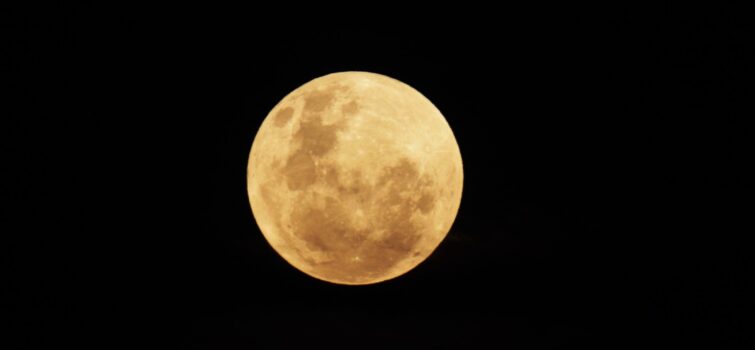An African Moon
We have always insisted that our winter night skies in the Waterberg are spectacular. With little cloud to obscure our views of the vibrant Milky Way, little or no moisture or humidity to diminish the faint glow of even the smallest or farthest star from the earth, the night skies are alive. There is so much that is represented in the celestial space around us that it is impossible to comprehend the magnitude of ‘space’ that surrounds the earth. We take this for granted in some small way, as we simply cannot get our minds to quantify this.
The connection between the earth, the moon, the Milky Way, the sun, the other stars and planets in our galaxy and the universe beyond is complex and so vastly significant that we cannot but blindly believe it will all just continue as is whilst we while away our insignificant times here on earth. There is a lot of energy and resource put into studying astronomy and while we last year celebrated the first of six successful landings on the moon by man 50 years ago, we simply know very little and understand even less about what lies beyond the atmosphere that supports us all here at ‘home’. The earth and the moon share a celestial relationship well known to most and as they pull on each other as they orbit the sun, the effects they share shape our days, seasons, years, and lives. This has been the case from time immemorial.
On Monday evening as the sunset, we watched the moon returning in the northwest skies, appearing as a mere slice of its full glory. The first quarter had begun. We were instantly reminded of the significance of the moon, the stars, and the Milky Way. These great forces that share the dark space around us have played interesting roles in the lives of all of Africa’s inhabitants for thousands of years before, and in many cases still do today. Sitting out on our deck, we asked the question; I wonder how the moon and the stars affect or a play a part in the southern African bushveld and those we share it with? This is where this journey begins.
Information on astronomy is well documented and a simple search on the world wide web dumps millions of fact pages right on your screen. How big is the moon? How did it come about? How far is the moon from earth? How big is the sun? How bright is the sun? How many stars are in the Milky Way? And more recently, how long until Richard Branson sets up home on the moon?
For all this information, the moon, the Milky Way, stars, and the sun had greater relevance in the lives of the earliest people and the fauna and flora in southern Africa, and today still shapes a world we have so much yet to discover.
Finding Our Path
The stars have been used since around 3000BC to assist man in navigating around the world, making astronomy one of the oldest sciences. At that point, the great discoveries of the world were limited as these early explorers set out from the island of Crete. Around 20BC the compass emerged as a pioneering tool for navigation and to this day remains the most widely used form of navigation even underlying advanced modern technological systems. Even within today’s highly technically advanced airline industry, navigating by the stars serves as a last resort.
Finding one’s way around the globe was made easier by the stars and later by technology but finding one’s way through life and its meaning was not so obvious when you looked to the heavens above. Knowledge, beliefs, and cultural influence brought about by observing the night skies is absorbingly interesting and have shaped human behaviour and life experiences in southern Africa in many ways.
Some of the oldest people in the world, the San, also pejoratively referred to as ‘Bushmen’, were vast in their beliefs and inclusions of the stars, the moon, and the sun in their daily lives, customs, and spiritual rituals. The various subgroups of San people had varying stories that would change slightly each time they were told, as they were recited by word and through memory, never written or recorded. From the /Xam and the !Kun or the !O Kung subgroups of San, their beliefs and understanding of the moon, sun, and stars are stories greater than any told in new or old fiction today. These beliefs and interpretations were not limited to the San and throughout Africa, groups of people of different languages, cultures, and beliefs had their daily lives interwoven with the skies under which they lived. Many of their beliefs and observations reflect the behaviour of the animals with which they shared the bush and give us an early insight into the way they themselves lived with and off the environment.
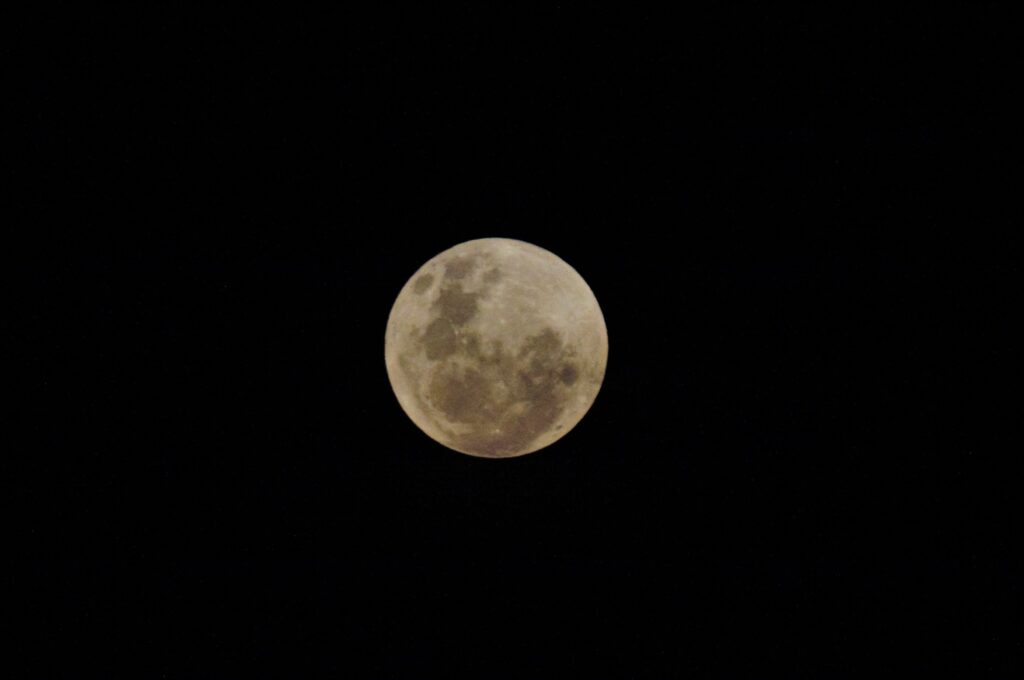
Wherever you are in the world, you will see the moon, the sun, and some stars, hopefully. Those visible vary as you move between hemispheres and in more modern times between cities and the countryside. In southern Africa, the Milky Way, and the south celestial hemisphere, which in summer and winter is dominated by different constellations, is easily recognisable on a dark moonless night. From the most famous constellation, the Southern Cross, to the less so but prominent constellations of, Orion, Taurus, Scorpio, the Pleiades (or Seven Sisters), and the two dwarf galaxies known as the Magellanic Cloud, all and many others were looked upon with interest.
The /Xam San people, tell that in the beginning the sun, the moon, the stars were all people. These were referred to as the early people: the first-there-sitting- people. Because they were referenced as ‘people’ they had unique human-like descriptions that were important in their understanding. Many of the other subgroups of the San, also referred to the stars being animals that were transformed to stars through changes of fortune.
They were referred to as the ‘things of the sky’ that did not have a direct influence on man or other living things they had left behind on earth.
The Significance Of The Sun
For the San, the sun is described as being an old man who lived on earth with all the other people. He lived alone in his hut and was a selfish man. The sun had a light that shone from his armpit but that shone only around his hut lighting his space, giving him warmth. The other people who lived on earth would collect ‘bushman rice’ the white ant and termite larvae as food, but they could not dry it out to eat, as there was no warmth. These people walked the earth in the cold and darkness as the sun selfishly refused to share his warmth and light. At their mother’s behest, a group of boys of the first bushmen were told to take hold of the sun and throw him into the sky above so that he shed his light over the earth for all. This they did and so the sun is present by day for all to enjoy. The principle of sharing in the San social laws is strong, and this story of the sun is testament to this. They had no currency in their society and their ‘economy’ was based on gifting.
The sun is also referred to as a death thing, in its association with heat, thirst, and exhaustion. At the start of an early morning hunt, the San would ask the sun to assist by steadying the hand of the hunter. At the time that the sun was put into the sky, the moon was already there but remained dark during the day. The sun was told to follow the moon across the sky.
The Magnificence Of The Moon
The moon in its various phases had already played a vital role in the life of the San, before the sun.
The moon is associated closely with the deity ‘Kaggen’ who was a trickster but revered as a god-like deity. The word ‘Kaggen’ refers to a ‘mantis’ but who would take on many different forms like humans as hunter-gatherers. The moon was made by Kaggen and is referred to as ‘him’.
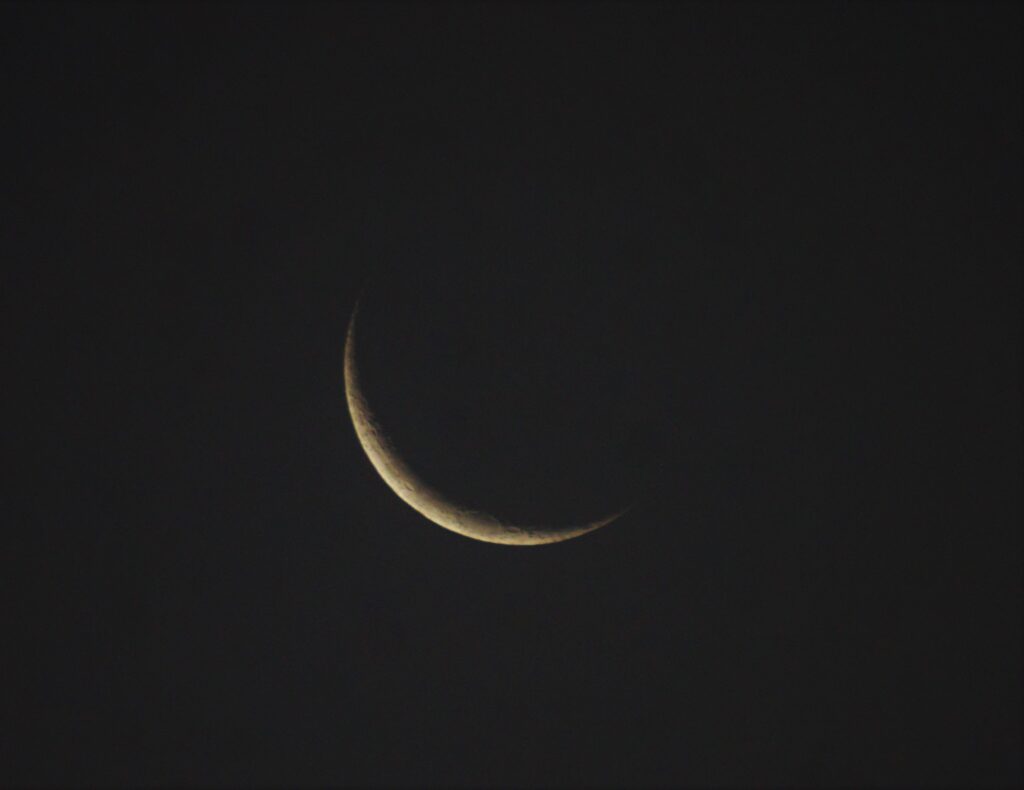
There are two stories told of how the moon came about. The first tells of Kaggen taking his leather shoe and throwing it into the dark sky commanding it to become the moon. The leather sandal was covered in the red Kalahari dust and so the moon glowed faintly in a red colour. The moon was cold as it is associated with darkness. The second story tells of Kaggen taking an ostrich feather placing it into the sky and commanding it to become the moon.
Because the moon was made by Kaggen, the trickster, the moon is able to talk. All of Kaggen’s things are clever, mischievous, and have the faculty of speech.
As the moon orbits the earth, it goes through its sequence of phases. From the new moon (not visible) to crescent moon, half-moon, full moon, half-moon, and then disappearing again to new moon.
Both moon and sun were men in the sky. The moon is told by the San, to have angered the sun. As the moon orbits the earth, chased by the sun, the sharp points of the sun ray’s cut pieces off the moon until it is just a sliver of itself. The moon being a trickster pleads with the sun to spare him as he is cut to his spine and his last piece of the body. The sun lets the moon go and the moon disappears to regain strength. As it reappears after the new moon it is growing, gaining strength until it is again a full moon. The process is repeated as the moon trickster angers the sun again.
The dark phase of the moon, the new moon, was asked by the San to assist with hunting. As it appears as a crescent moon to give some light to the hunt, it is believed to be holding the souls of the dead. The young moon is burdened by the dead which it carries in its hollow. As the crescent moon sits with its points upward, wounded by the sun, it is called the carrying net of the dead.
Early evidence and spoken records indicate the significance of the sun’s position in the day and give reference to the time of day used by early San people. The phases of the moon were more relevant and were used to count the number of days.
Counting the days by moon phases, as in a lunar calendar, was particularly important for females in communities. Young females showing early signs of puberty went through a rite of passage and rituals were performed that were associated with securing her future fertility. Using the moon phases was therefore important, and as a result, a lunar calendar stick was often used.
Possibly the oldest known mathematical device in the history of man is evidence of this. The Lebombo bone.

It was found in the Border Cave in the Lebombo Mountain range bordering Swaziland and South Africa in the 1970s and resembles other more recently found counting sticks. The bone is believed to date back 35,000 years. It is the fibula bone of an adult baboon, which has 29 notches in it, possibly representing the 29 days of the lunar month or the synodic month, reference to the number of days between two new moons.
The significance of the baboon bone is interesting in that wizards and sorcerers in many African beliefs, travelled by night on the backs of baboons as well as other animals. Reference is made to wizards moving at night under the cover of darkness, returning to their huts in the early morning, placing the baboon in a pot, and burying it in the floor. Baboons and the moon had some kind of connection it would seem.
Do Not Sail Using Someone Else’s Star
An African proverb interpreted as: “do not follow someone else’s success and hope for the same success. Create your own”.
It is a common belief by the San and the Tswana people, that “the sun in the evening draws his blanket of darkness over himself to keep warm during the cold night. This is an old worn blanket with many little holes in it. The sun’s rays shine through these holes, forming the stars”.
These stars were all people of the early race. Many stories are told of how these people and or animals became the stars or constellations we see. These early characters of man and animals were transformed to the skies at stars after breaking a taboo on earth. The star names and descriptions were given in association with animals and objects seen on earth at certain times of the year. There is belief that the stars’ behaviour was a response to a human need, and so in rituals, the San would interact with the stars to obtain food or water.
The Southern Cross
The Southern Cross, prominent in our winter night skies more so than our summer skies features prominently in these stories. The constellation consists of the ‘cross’ and the two pointer stars. The pointer stars were once two lion men. These lion men wandered the earth but were malevolent and foolish and this resulted in their death. These early race characters had feet like lions but spoke like people. The most prominent three stars of the ‘cross’ were lion females. The Tswana believe the Southern Cross constellation to be giraffes and call them Thutlwa. The bright star is the male giraffe and the two less prominent stars are the females.
Orion
The sword of Orion, the hunter, is described as being three male tortoises strung together. The belt of Orion are three female tortoises suspended on a stick. Orion is prominent in our summer night sky, signifying the rain season. This reference is made to the activity of tortoises in summer where they come out of their winter dormancy. The Tswana believe the belt of Orion represents three dogs chasing the sword stars which are three pigs. These three pigs in themselves represent the time of year that warthogs give birth and usually in litters of three, as Orion appears first in early summer.
The Milky Way
The Milky Way is described as being made by a girl. At night when there was no moon, there was no light. The girl took ashes from a fire and gently scattered them into the dark giving instruction to them on where to settle. The Milky Way resembled the large herds of Springbok moving across the landscape, with the stars in the Milky Way ever moving across the skies. The San also observed the orientation of the Milky Way at different times of year. This was an indication for them of the change in season to come. An east/west orientation indicated rain would fall. An orientation of north/south indicated no rain would be coming.
The Pleiades
The Pleiades, also referred to as the ‘Seven Sisters’ appear as a small group of clearly visible stars close to the constellation of Taurus. Mostly visible at night in summer, it appears early morning low in the east in winter. In summer night skies, they are referred to as just ‘summer things’ with little relevance. In winter they are referred to as an ostrich nest with eggs, as they appear in the early morning. This is interesting as ostriches in the wild, lay their eggs in June/ July (winter) taking about 40-45 days to incubate so the chicks are born early spring. The Tswana refer to the Pleiades as ‘digging stick stars’ and are an indicator of the time to start ploughing and preparing for the new growth season ahead. This is when the stars appear right above in the night sky. They call them Selemela with lema meaning to plough or cultivate.
At Makweti Safari Lodge, standing at the Indaba Lounge, looking over room 4 towards the east at about 5 am on a winters morning, you will clearly see the Pleiades.
The Magellanic Clouds
The Magellanic Clouds appear as two clouds in the south celestial hemisphere. These are two dwarf galaxies that slowly dance their way around our Milky Way. The San referred to them as the ‘ostrich eggs in the nest’. The larger of the two ‘cloud’ galaxies is seen more clearly in summer and appears to resemble ostrich eggs packed neatly on grass when collected by the San. Another reference is made to that of a steenbok. The larger cloud being the male and the smaller the female, probably alluding to the coming together of this monogamous species of antelope who spend their time apart outside of the breeding season, coming together again to mate in the summer.
The Tswana look at these ‘star clouds’ as symbols of the growing season to come. The larger cloud is called Kgoro and the smaller cloud Tlala. If Tlala is on top, then the rains will stay away and there will be drought and famine. If Kgoro is on top of Tlala there will be rain aplenty. The larger cloud is more clearly visible on top through the months of September to January, which coincides with the rain season.
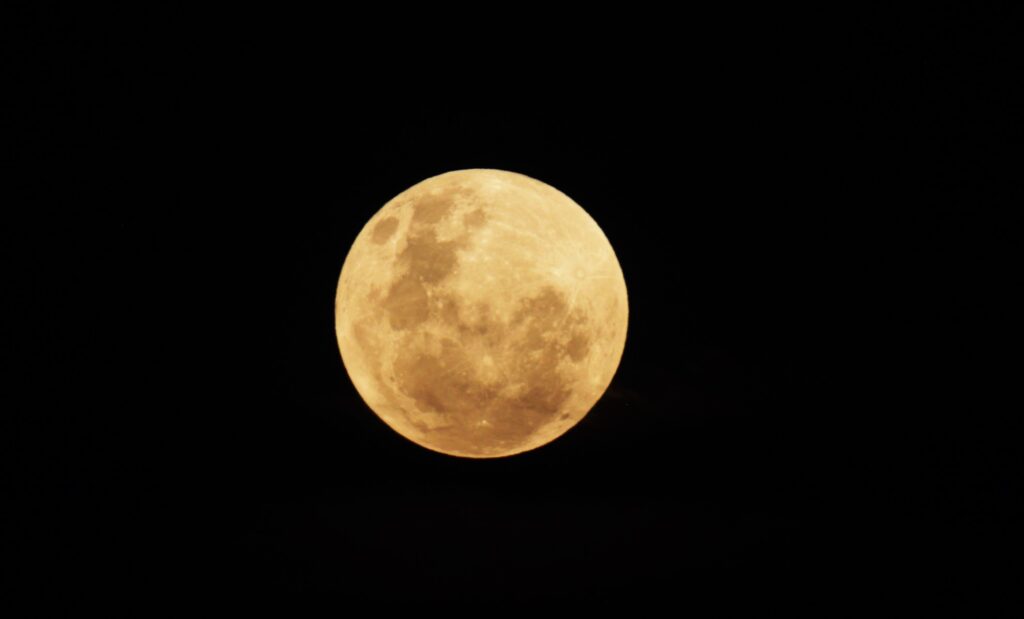
A Changing World Under An Ever-Changing Night Sky
The moon in particular plays a critical role in the animal kingdom and its effects are widespread. From marine ecosystems responding to the rise and fall of tides to fish species spawning under full moons where the water temperature and availability of food coincide with this lunar phase, to the nocturnal African dung beetles finding their way with the light of the moon and the solar glare from the Milky Way. Animals respond.
The presence or absence of moonlight, along with the predictable changes in brightness across the lunar cycle, can shape reproduction, foraging, communication, and other aspects of an animal’s world. Studies into the effects that moonlight has on the behaviour of animals have catalogued these effects for decades with some new and interesting behaviours recently being added.
Lions in particular benefit from the absence of the moon. As predominantly nocturnal ambush hunters, hunting in the dark favours them more so than their prey. The Tswana believe that during a lunar eclipse, the lion has placed his paw on the moon to block the light so he may hunt more successfully. In east Africa, studies have shown how the prey species of the lion also react to the lunar phases, particularly wildebeest and zebra. Results showed that behaviour patterns in these two herbivore species were altered with the phases of the moon changing. During full moon phases, wildebeest would congregate in safer areas as night fell, and as the moonlight intensified, they would move into areas that they would not occupy during dark moonless nights, taking greater risks to obtain food during full moonlight.
Zebra would act more unpredictably during Full Moon phases and would be more active before the moon was full and at its brightest. Although possibly riskier, they would venture out before the moon rose rather than in response to the moon having risen.
On dark nights, we often observe more activity of some nocturnal species such as genets and civets on the reserve who possibly use the darker nights to forage quietly unnoticed. This scenario is twofold in that with more light from the moon, the easier it is to locate prey, particularly insects. Although the darker the night, the less obvious one is wandering around looking for food. Deciding in which moon phase to forage which is more productive and yet less risky may be driven by the need for food or time of year. It is also most likely due to the type of terrain. Nocturnal antelope such as duiker who prefer densely wooded areas would benefit more from a dark night than a bright moonlit night, one would assume. For most prey species, foraging at night is not worth the risk, regardless of the moon or not. warthogs will usually bed down before sundown, although in summer we have seen males wander around later, making use of the warmer nights and moonlight to forage in open areas. The mothers with piglets, do not partake in this risk. In Winter though we have witnessed warthogs forage well into the night. This is due largely to lack of food availability rather than good light for feeding and predator spotting. The risk to find food is great but the risk of not getting sufficient nutrition through winter is greater.
Most predators are nocturnal, bar cheetah, but all are opportunistic. Their hunting strategies may be influenced by the moon phases, but they are not reliant on this. Lion and leopard both have clearly visible white patches on the lower eyelid. These patches act as reflectors at night, illuminating the eyes with as much available ambient light as possible. The moon is friend or foe depending on who you are, but it is clear in the African bush that it has a vital role to play for all.
More recently, the presence of the full moon has not been viewed upon as a sign of fertility, wealth, strength, or of a new or great beginning. As the moon has gained his strength once again to contend with the Sun, he has brought with him a new and frightening change on earth. All too often referred to as a ‘poachers’ moon’ the full moon has become a bad omen for anti-poaching teams across Africa. With its full glory reflecting the Sun’s light back down through the night, rhino poachers take advantage of this. There are few, well-documented records of the potential increase in rhino poaching at full moon, but reference is clear to the added advantage this gives. In 2019, an average of three rhino were killed every day. In some conservation areas, this was higher. This sad reference to a ‘blood moon’ is a reality that many turn their backs to. The eternal manipulator, man, has turned the delight and innocence of stories told of a mantis and his shoe into a bloodthirsty money-driven illegal trade. The moon is moving away from earth, at just over 3cm a year, and is likely to continue for another 15 billion years until these two celestial mammoths’ gravitational influences stop the moon on its course. If poaching continues with three rhinos lost daily to the greed of man, the moon will be 60cm further from the Earth than it is today, when there will be no more rhino to look up and enjoy its glowing glory.
Recording The Past
When I started this research, I was unsure what information would be available on the effects the moon, in particular, has on life in the southern African bushveld. For the past 4 years at least, Jessica and I have discussed the lack of available information on how the night skies were and still are perceived by local indigenous groups and how this was in a time gone by. It turns out that is not so much the lack of it, but the non-availability of this information. It is very much alive, just poorly recorded.
How the animals react and the changes in behaviour to the moon and it’s phases is more observational and not well documented or understood, although there are numerous research programs that have looked into this, more so in east Africa than southern Africa.
For many of the San people’s stories that emerged from indigenous knowledge of the sun, the moon, and the stars, there are varying versions. For instance, each group and subgroup of San people told different stories in slightly altered versions however the core theme and principle remain the same throughout. The story of the birth of the sun has a number of versions but are similar in their theme and the ultimate birth of the sun in the sky is the same. It is a matter of who cares how it got there, it is still there and has the same significance to us all. This is a testament to stories and knowledge passed down through many, many, generations by word and through storytelling, with it never being recorded to parchment. A historical broken telephone.
For this narrative, I chose to focus more on the San people, including all subgroups, for no particular reason other than I share the belief that their way of life was not exploitative, and in cohabiting with nature was significant. The Tswana beliefs are relevant in that the area in which the reserve and most of the Waterberg lies falls mostly within this language groups’ region and has more of a local relevance than any other of the southern African language groups. With time, modern influences and western knowledge have changed the thinking in many language groups, the San however were never given this opportunity. The San were persecuted by explorers since the day the first European set foot on southern African soil. Most of their culture, beliefs, customs were lost as these early people were hunted like wild animals. Without the dedicated efforts of very few western colonists, we would have no knowledge or insight into this mystical world, the San found solace in.
The notebooks and journals of Willem Bleek and Lucy Lloyd in 1860 – 1874 are invaluable and although interpreted from interviews with 2 subgroups of San people, they are a recorded reminder that so much knowledge has been lost to the past for never having been officially recorded. For this reason, the 12000 pages of recordings in their notebooks now belong to UNESCO Memory of the World Register. Their books have been preserved for all and remain under the curatorship of the University of Cape Town who have digitised them for all to enjoy. These valuable notebooks and records are available online, just follow the reference link below.
I implore the reader with the desire to discover more of the fascinating subject of ‘ethnoastronomy’ to read Dr P.G. Alcocks book Venus Rising: South African Astronomical Beliefs, Customs and Observations. Special reference must be made to the pages he has put together based on numerous recounts made in the late 19th and early 20th Century on the many southern African ethnic groups’ beliefs on Astronomy.
His book is also available as a free download online through the Astronomical Society of South Africa (ASSA), just follow the link in the references below.
1st May 1873. “He was kneeling by the side of his bed, apparently in prayer, his head buried in his hands in his pillow. For a minute they watched him. He did not stir. Then one of the men slowly went forward and softly put his hands to Dr Livingstone’s cheeks. His body was almost cold. They covered him and went to sit by the fire”.
There was no moon that night. The new moon gone to gather the souls of the dead. The life of arguably the world’s most famous explorer had been gathered. Coincidence?
“Africa has its mysteries, and even a wise man cannot understand them, but a wise man can respect them”.
‘Mama Africa’ the late Miriam Makeba (1953-2008)
- Text and photographs: Neil Davison
- Lebombo Bone image, courtesy of www.afrolegends.com
References:
- 30 years of personal observations by the author on various Reserves in South Africa including Welgevonden Game Reserve
- ‘The Sky’s Things’ / Xam Bushman ‘Astrological Mythology’ as recorded in the Bleek and Lloyd Manuscripts, J.C. Hollman, African Sky, Vol 11, pg8
- Venus Rising: South African Astronomical Beliefs, Customs and Observations, P.G. Alcock., 2014, Pietermaritzburg
- The Scramble for Africa, Thomas Packenham, Abacus History, 1991, St Ives Place
- Beat about the Bush – Mammals, Trevor Carnaby, First Edition, Jacana, Johannesburg, 2007
- The Behaviour Guide to African Mammals, Richard Despard Estes, Russel Friedman Books CC, 1995.
- http://lloydbleekcollection.cs.uct.ac.za/index.html
- https://assa.saao.ac.za/astronomy-in-south-africa/ethnoastronomy/
- https://www.rmg.co.uk/discover/explore/south-african-star-myths
- https://afrolegends.com/2019/05/17/the-lebombo-bone-the-oldest-mathematical-artifact-in-the-world/

